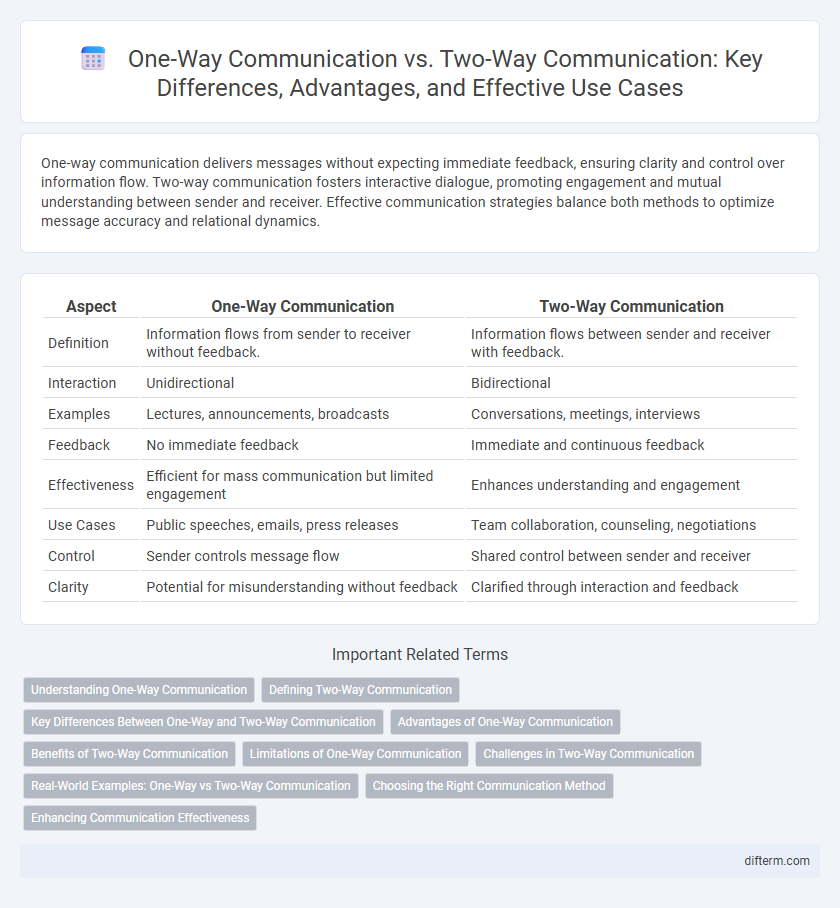One-way communication delivers messages without expecting immediate feedback, ensuring clarity and control over information flow. Two-way communication fosters interactive dialogue, promoting engagement and mutual understanding between sender and receiver. Effective communication strategies balance both methods to optimize message accuracy and relational dynamics.
Table of Comparison
| Aspect | One-Way Communication | Two-Way Communication |
|---|---|---|
| Definition | Information flows from sender to receiver without feedback. | Information flows between sender and receiver with feedback. |
| Interaction | Unidirectional | Bidirectional |
| Examples | Lectures, announcements, broadcasts | Conversations, meetings, interviews |
| Feedback | No immediate feedback | Immediate and continuous feedback |
| Effectiveness | Efficient for mass communication but limited engagement | Enhances understanding and engagement |
| Use Cases | Public speeches, emails, press releases | Team collaboration, counseling, negotiations |
| Control | Sender controls message flow | Shared control between sender and receiver |
| Clarity | Potential for misunderstanding without feedback | Clarified through interaction and feedback |
Understanding One-Way Communication
One-way communication involves the transmission of a message from a sender to a receiver without expecting immediate feedback or interaction, commonly used in mass media, lectures, or announcements. This method allows for clear, controlled dissemination of information but often lacks the engagement and clarification opportunities found in two-way communication. Its effectiveness relies on the sender's ability to convey the message clearly and the receiver's ability to understand and interpret it independently.
Defining Two-Way Communication
Two-way communication involves an interactive exchange of information where both sender and receiver actively participate by sending and receiving messages, enabling feedback and clarification. It fosters collaboration, improves understanding, and reduces errors by allowing immediate responses and adjustments in communication. This dynamic process is essential in effective teamwork, customer service, and conflict resolution, promoting a more engaged and informed audience.
Key Differences Between One-Way and Two-Way Communication
One-way communication involves sending messages from a sender to a receiver without expecting feedback, often used in broadcasts, announcements, or instructions. Two-way communication allows for interactive dialogue, where both sender and receiver exchange information, fostering feedback, clarification, and collaboration. Key differences include the flow of information--linear versus reciprocal--and the level of engagement, where two-way communication enhances understanding and responsiveness, critical in teamwork and customer service scenarios.
Advantages of One-Way Communication
One-way communication ensures clear, consistent messaging by delivering information directly from the source to the receiver without distortion or feedback delays. It is highly efficient for disseminating instructions, announcements, or emergency alerts where speed and accuracy are critical. This method reduces the risk of miscommunication and maintains control over the message content, making it ideal for broadcasting standardized information across large audiences.
Benefits of Two-Way Communication
Two-way communication enhances clarity and reduces misunderstandings by allowing immediate feedback between sender and receiver, fostering a more interactive and engaging exchange of information. It promotes collaboration and problem-solving in real-time, leading to better decision-making and stronger relationships within teams or organizations. This dynamic communication process also supports continuous improvement by enabling participants to ask questions, provide suggestions, and address concerns promptly.
Limitations of One-Way Communication
One-way communication limits feedback opportunities, reducing the ability to clarify messages and adjust understanding in real-time. It often leads to misinterpretations and decreased engagement due to the absence of interactive dialogue. This communication style can hinder collaboration and problem-solving in both organizational and personal contexts.
Challenges in Two-Way Communication
Two-way communication faces challenges such as misinterpretation of messages, which can lead to confusion and errors in decision-making processes. Differences in language proficiency, cultural backgrounds, and communication styles often create barriers that hinder mutual understanding. Time constraints and lack of active listening skills also reduce the effectiveness of interactive dialogue, impacting overall communication efficiency.
Real-World Examples: One-Way vs Two-Way Communication
Emergency alerts via radio broadcasts exemplify one-way communication, where information flows from authority to the public without immediate feedback. Customer service chatbots represent two-way communication by enabling interactive exchanges that address user queries in real time. Social media platforms combine both methods, allowing initial announcements followed by dynamic user engagement and dialogue.
Choosing the Right Communication Method
Selecting the appropriate communication method depends on the message's purpose, urgency, and desired feedback. One-way communication suits announcements or instructions requiring clarity without immediate response, while two-way communication fosters interaction, enabling clarification, collaboration, and relationship-building. Organizations benefit from balancing both to enhance efficiency and engagement in diverse communication scenarios.
Enhancing Communication Effectiveness
One-way communication delivers information clearly and efficiently, ideal for broadcasting messages to large audiences without requiring immediate feedback. Two-way communication fosters interactive dialogue, enabling real-time feedback, clarification, and mutual understanding, which significantly enhances communication effectiveness. Employing two-way communication techniques in organizational settings promotes collaboration, innovation, and stronger relationships among team members.
One-Way Communication vs Two-Way Communication Infographic

 difterm.com
difterm.com